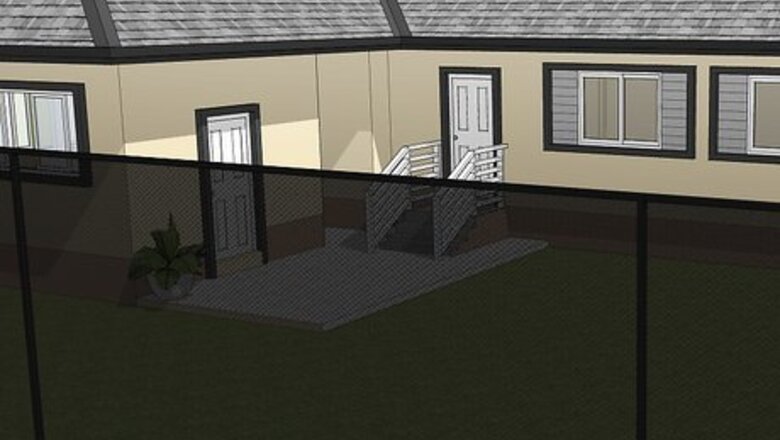
views
- Cover your fence with a mesh windscreen for the cheapest and quickest option. For a more attractive option, weave slats or privacy tape through the links.
- Secure a bamboo or reed screen across your chain link fence using zip ties. Or, install a wooden fence panel between the fence posts for more durability.
- Plant climbing vines, shrubs, or hedges along the perimeter of your fence to grow in a natural privacy barrier.
Mesh privacy screen
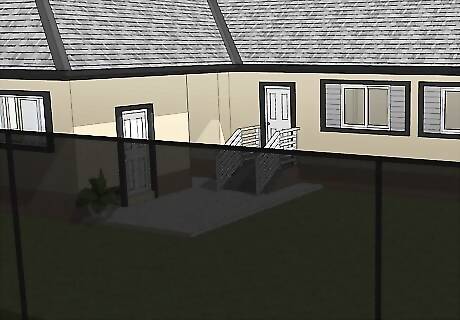
Mesh windscreens cover the largest area for the lowest price. Mesh windscreens have tight, durable webbing that’s weatherproof and difficult to see through. These rolls of mesh come in multiple colors or patterns so you’re able to customize the look of your fence. Installing your mesh privacy screen is really quick and easy too—just pull the screen tight over your fence, slide zip ties through its grommets, and secure them tightly to the chain links. Coverage: 80–90% Cost: $8–10 USD to cover 40 square feet (3.7 m)
Reed screens

A lightweight reed screen gives your fence a natural look at a low cost. Reed screens are thin pieces of bamboo that come in rolls that easily spread out across your fence. Stand the roll or reed fencing vertically on a 2 in × 8 in (5.1 cm × 20.3 cm) board against the fence. Place wire ties every 12 in (30 cm) across the top and bottom rails of the fence to secure the reeds. For even more privacy, attach a second layer of reed screens to fill in more gaps. Coverage: 80% Cost: $20–30 USD to cover about 40 square feet (3.7 m) Reed screens aren’t as durable as other privacy options, so you’ll usually have to replace them within 2 years.
Privacy tape
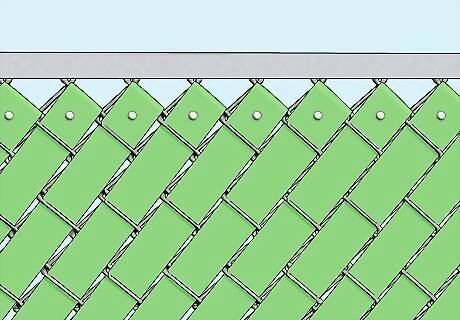
Chain link privacy tape fits diagonally in the links to cover the gaps. Similar to fence slats, privacy tape is made from strips of waterproof plastic that are the same width as the slats. To install the privacy tape on your fence, just weave the tape diagonally through the gaps in the chain link from the bottom to the top. Then, just use the fasteners installed on the ends of the tape to secure it to the chain links. Coverage: 70% Cost: $35–40 USD to cover 40 square feet (3.7 m)
Chain-link slats
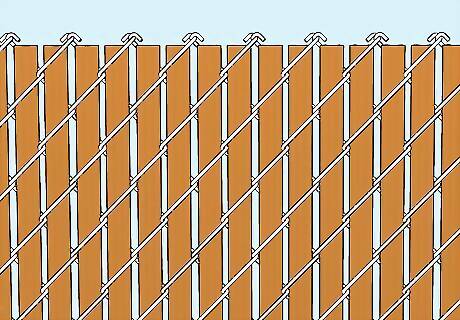
Slats fill the vertical gaps in between your chain links for an easy install. Chain link slats are thin pieces of durable, weatherproof plastic that can last up to 15 years in your fence. When it’s time to install them, all you have to do is feed the slats from the top of the fence so they weave between the links. While it may take a little time to add slats to your entire fence, you’ll have lasting privacy in your yard. Coverage: 85% Cost: $45–100 USD to cover 40 square feet (3.7 m)
Artificial hedge screen
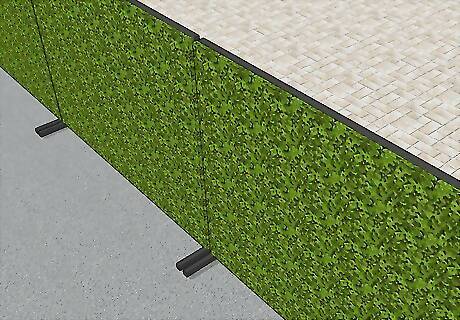
A hedge screen transforms the look of your fence with a bit of greenery. If you want the look of a large privacy hedge without the hassle of growing one, a hedge screen with printed or artificial leaves looks great and is so easy to install. Look for a hedge screen that’s the same height as your fence, and hold it up to the chain links. Feed zip ties through the grommets in the hedge screen and tighten them against your fence until they’re tight. Coverage: 80% Cost: $40–55 USD to cover around 35–40 square feet (3.3–3.7 m)
Bamboo screens

Weather-resistant bamboo adds a tropical aesthetic to your yard. For a more striking look on your fence, thicker bamboo poles come in a variety of heights and colors for the style you want. When you install your bamboo screening, make sure that the stalks are closed on top to keep them waterproof. Just roll the bamboo across the length of your fence, and secure the stalks to the tops and bottoms of your fence post with zip ties. Because the bamboo pieces are larger and more durable, they’ll maintain privacy in your yard for 10 years or longer. Coverage: 85% Cost: $65–100 USD to cover 40 square feet (3.7 m)
Wooden fence panels
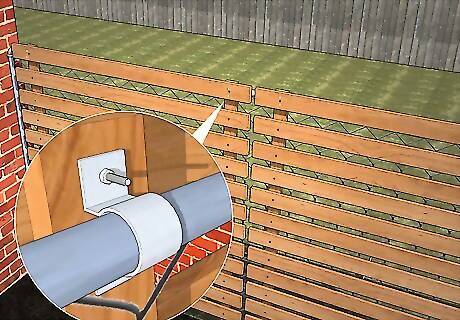
Fence panels fill in all the gaps in your fence to add the most privacy. You can either buy pre-made panels from a home improvement store, or build your own fence panels for a cheaper DIY. Wood fence panels are also one of the most durable options since you’re able to stain or paint them when they start looking worn. Line the side of the panel with one of the vertical metal posts on your chain link. Wrap a U-bolt around the metal post and attach it to the top and the bottom of the fence panel to secure it. Coverage: 90–100% Cost: $65–150 USD to cover 40 square feet (3.7 m) Custom-made wood fence panels are usually easier to repair since all you have to do is detach a damaged slat and reattach a new one in its place. For a more decorative fence, use privacy lattice panels that have a tight criss-crossed pattern with small gaps instead.
Climbing plants
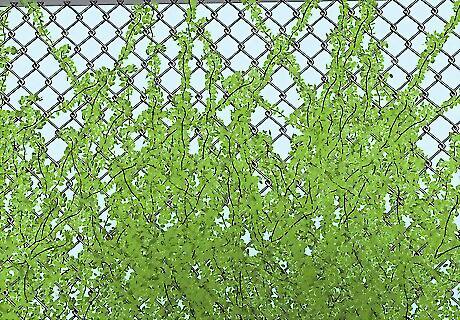
Grow ivy, morning glory, or creeping fig to fill in your fence with vines. Climbing plants have vines that naturally climb up the chain links to cover them with leaves and foliage. Check the vine spread for the plants you want, and space them that far apart along your fence. As you grow the plants, tie the vines back to the fence with wire or zip ties to help train them to grow upwards. It may take a few years to completely cover your fence, but the lush greenery will add a ton of privacy. Coverage: 100% (after growing for a few years) Cost: $15–40 per plant One ivy plant can grow almost 100 feet (30 m) of vines, so you only need 1 plant per 40 sq ft (3.7 m) section of fence. Otherwise, plant ivy about every 10 feet (3.0 m). For morning glories, plant them 1 foot (30 cm) apart. You’ll need about 6–10 plants to cover a 40 sq ft (3.7 m) section of fence. Other good climbing plants to grow include wisteria, star jasmine, honeysuckle, and climbing hydrangeas.
Shrubs or hedges

Growing plants next to your fence creates a natural privacy barrier. You can either grow the same bush along the entire perimeter to create a hedge fence or plant different shrubs for more visual interest. Look for plants that are evergreen and have “fastigiate” or “columnar” in their name since they’ll have tall, dense foliage all year long. While your natural privacy barrier will require a little more care and attention, it’s a great way to maintain your privacy for years to come. Coverage: 90–100% (after growing for a few years) Cost: $50–100 per plant Deciduous plants grow faster, but they lose their leaves in the fall and winter, so they may not offer the most privacy. Many privacy hedges, such as barberry and dogwood, spread over 5–6 feet (1.5–1.8 m), so you’ll only need 1–2 plants to cover a 40 sq ft (3.7 m) section of chain link. Always pick plants that are native to your region so you don’t introduce invasive species.




















Comments
0 comment